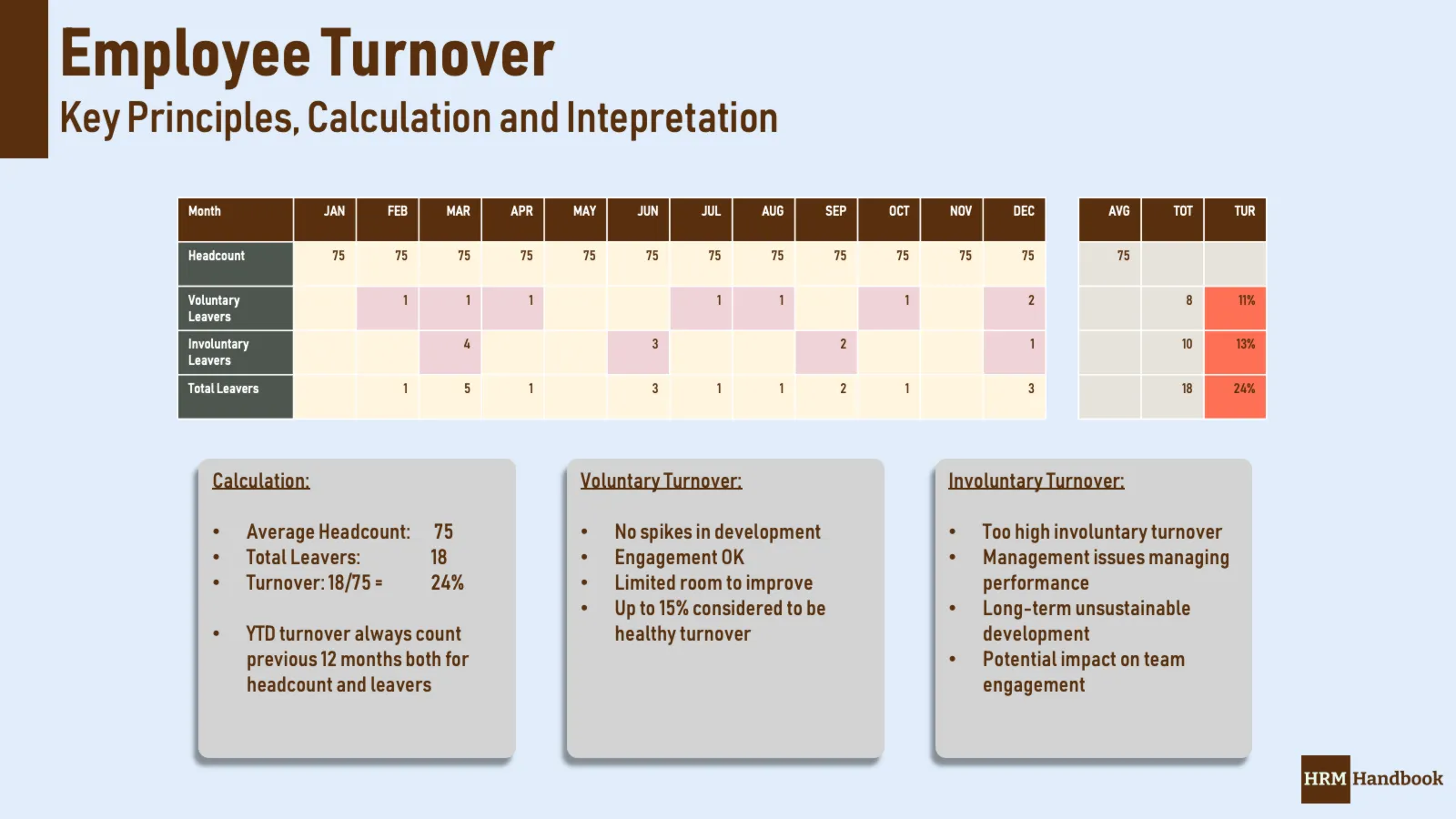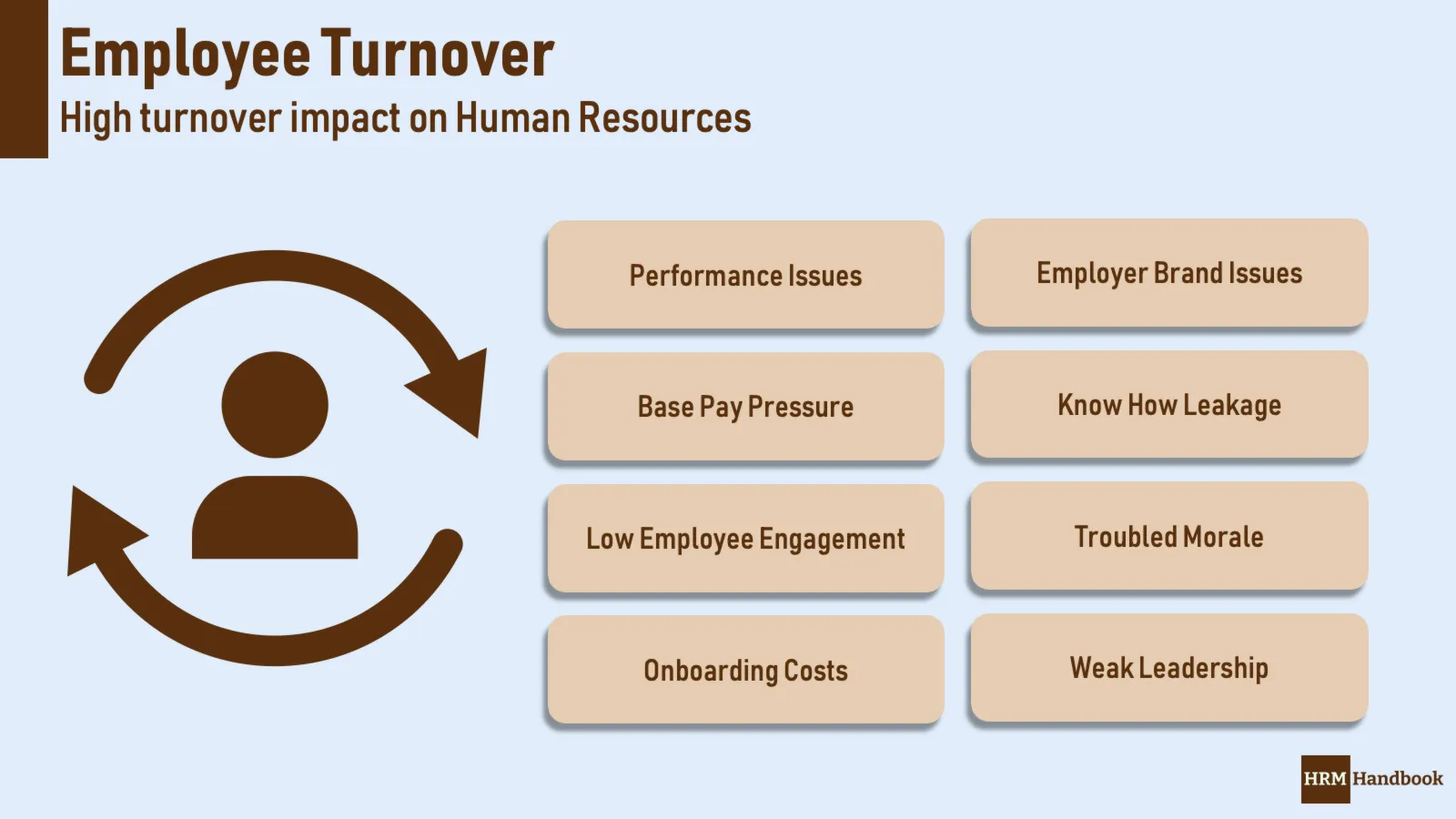Employee Turnover
Employee turnover, or also the turnover rate is the ratio of employees leaving the organization compared to the total workforce at a given moment. It reflects how stable the workforce is, in a way, what percentage of employees depart during a given period. Usually, it is reported as the year to date metric, and it is reported as a percent of the total workforce.
Most importantly, it is crucial to keep in mind that it is an HR metric that describes the past. It does not predict the future. It can increase or decrease without any early warning. However, seeing an increasing trend can navigate the team to look for the issue in the area.
However, any significant change in the business is quickly reflected in the turnover rate (some organizations prefer to watch closely attrition rate). There can be a sharp increase because employees look for a more stable and safe place to work. Too many changes usually destroy all initiatives focused on turnover management.
Employee Retention is an HR tool focused on the future of the company’s workforce.
Overall, the interpretation of the result is straightforward. If the turnover rate is 25%, a quarter of the workforce will leave every year. However, you always need to understand the background. Otherwise, interpretation can be misleading.
Most managers have this metric in their goals and objectives. It is one of the HR metrics that managers and leaders can influence directly. Commonly, there are significant differences among units in the organization - from top stars to losers.
Measuring and analyzing employee turnover is an essential HR analytical skills. Also, leaders and managers are interested in measuring turnover trends because it indicates issues, challenges, and potential risks. There are many kinds of turnover, but the voluntary turnover is usually the most important because a high voluntary one is a sign of an ill organization.
High employee turnover is usually connected with issues in following HR Management areas:
- wrong HR Strategy,
- unmanaged HR Challenges,
- HR Agenda not meeting employee expectations,
- Compensation and Benefits; base pay is the most common issue,
- corporate values and corporate culture,
- job design and job profiles, having no responsibilities usually or unbalanced ones,
- wrong Employer Brand and Employer Value Proposition,
- unappealing career opportunities,
- leadership and management style.
Additionally, it is the metric that indicates issues in people management policies and practices. A high level of turnover usually leads to further and more in-depth analysis, often including employee surveys and interviews with managers and employees.
Employee Turnover Definition and Calculation
Employee turnover, or employee turnover rate, is the measurement of the number of employees who leave an organization during a specified time, typically one year.

While an organization usually measures the total number of employees who leave, turnover can also apply to subcategories within an organization like individual departments or demographic groups.
We generally recognize two kinds:
- voluntary and
- involuntary.
The first one measures employees who terminated the employment relationship with the organization. The other one measures the rate for employees who were asked to depart.
Why is turnover important?
Modern business is about continuous change and stability. Leaders require both, and turnover can be a measurement of stability. It does not tell anything about the future, but leaders can usually use it as a basic guideline when setting expectations and goals.
Additionally, it indicates how people management practices and procedures work in the organization; a lower turnover signifies good practices in place. Also, the brand of the business is considered as a top-quality employer.
Such businesses usually enjoy higher productivity, and they spend less on training and development of new joiners. This allows them to invest in the development with a higher value-added.
Leaders watch trends, and they ask Human Resources to report the metric regularly. They want to understand the underlying root causes because they can improve employee morale with a more stable workforce, and they can increase performance and productivity. Also, they secure know-how, and they decrease the risk of a single person dependency.
How to manage and decrease employee turnover?
Decreasing high turnover is a difficult task, which requires the full involvement of the leadership team and Human Resources. The HR leader has to lead and manage the initiative, but she cannot achieve successful results just on her own.
Usually, a dedicated project team needs to investigate root causes, talk to employees and managers, and confirm initial findings with relevant data. Making regular confirmations is essential so that the team solves the real issue behind high employee turnover.
There is no simple cure; it is a long term initiative bringing results slowly. It requires a leadership team commitment, and the CEO must regularly talk about the issue with other managers to achieve sustainable results.
Cost of Employee Turnover
Surprisingly, the high turnover rate comes with its cost. In Human Resources, we usually do not realize the real cost of turnover, and we underestimate its impact on overall business results.
However, it impacts the following areas:
- high direct recruitment costs, like recruitment agencies and headhunters,
- direct costs of the induction of new hires,
- base salaries of new hires to be upgraded,
- loss of productivity as new hires are less productive than the rest of the workforce,
- lower sales volumes due to too many new joiners in the team,
- decreased morale of the workforce due to continuous changes in the organization,
- loss of know-how that needs to be bought externally,
- and broken employer brand.
What is healthy employee turnover?
A low level is not healthy; a high level is dangerous. However, it is different for each department in the organization. Call Centers usually live with a yearly turnover of 30% - 50%. They set processes and induction procedures to prepare a new joiner to be fully productive within the first days of employment.
On the other hand, a highly specialized unit can be damaged with a rate of 15%. The more skills and competencies are required, the more dangerous high turnover is.
Issues with Employee Turnover
As always, the devil is in the detail. Employee Turnover rate can be misleading. The workforce can be stable; just a small portion of employees can fluctuate. However, overall turnover will be extremely high. It is essential to have another critical look at the metrics to ensure that we understand the number.

Also, turnover should never be used as a single number. It is essential to understand which department or a group of employees suffer most. A high-level helicopter view does not help to find a solution that works.
The last issue is its stability over time. As you measure over a year, each shock comes slow and lasts long. There is no visible and sharp spike and a sharp decrease. Turnover increases slowly and decreases slowly, hiding the cause and effective working solution.